I’ve upgraded this flax weaving website. Click the following link to go to my new site: “A full upgrade of my website”.
I’ve upgraded this flax weaving website. Click the following link to go to my new site: “A full upgrade of my website”.
Reviews of books on NZ flax weaving
- On this page
- Flax weaving techniques
- Flaxwork exhibitions
- Flax in Māori culture
- Growing and harvesting flax
All of the books (and videos) reviewed below can be borrowed from New
Zealand public libraries. Books that are still in print can be bought online
from Fishpond (a New Zealand bookseller), Amazon (a US bookseller)
or — in some cases — Collectiblebooks (a New Zealand bookseller that doesn’t take credit cards online but does take internet banking or direct credit payments). Generally, Fishpond offers a lower shipping-inclusive price for NZ buyers than Amazon. Second-hand copies of out-of-print books can often be found at Amazon or Abebooks. The links below will take you to the page on which the book is offered for sale, if it is currently available.
Books and videos that include flax weaving techniques
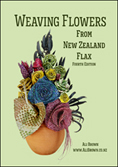
Weaving Flowers from New Zealand Flax
Ali Brown. Self-published, 2009. Fourth edition, 2016
Buy directly from me.
In my experience as a flax weaving tutor, flax flowers are the first thing that most beginners want to learn to weave. I’ve never come across instructions for weaving flax flowers in any of the books I’ve read, so I wrote a book that has instructions on how to weave nineteen flower and foliage designs. Photos from the book are shown on my Book page, along with details for buying the book. See more information about the book here.

Weaving Baskets, Backpacks, Boxes and Other Projects
Ali Brown. Self-published, 2015.
Buy directly from me.
This book covers a comprehensive range of basket-making, starting from a simple woven folded-over basket (kete ), to complex patterned baskets and backpacks, as well as boxes, platters, trays, vases and pots. Each project has illustrated instructions and colour photos that show step-by-step instructions for weaving using diagonal weaving and over 70 different techniques and methods used in basket-making are included. Most of the samples in the book are woven with New Zealand flax but any natural or manufactured material that can be made into long thin strips can be used, including palm leaves, strapping, bark and paper. See more information about the book here.

Weaving a Large Container from New Zealand Flax
Ali Brown. Self-published, 2012. Second Edition, 2016
Buy directly from me.
The book contains detailed instructions for weaving a large container with whole flax leaves, along with illustrated step-by-step instructions of the process. Instructions for several different ways to complete the top edge are included, and several ideas for using the basket are shown. This is a unique use of the whole of the flax leaf and this style was traditionally used for vegetable gathering baskets. See more information about the book here.

Fun and Functional Flax Weaving
Ali Brown. Self-published, 2020.
Buy directly from me.
Fun and Functional Flax Weaving shows how basic weaving, knotting, twining and plaiting can be used for the creation of any number of items that have wide appeal for their attractiveness and functionality. Suitable for both beginning and experienced weavers this book is a useful resource for any weaver, groups of weavers, educators or tertiary training venues looking for new ideas for their weaving. See more information about the book here.
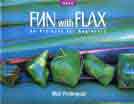
Fun with Flax: 50 Projects for Beginners
Mick Pendergrast. Reed Publishing (NZ) Ltd, 1987.
Buy online from Fishpond or Amazon.
This is an excellent book for beginners. As the title indicates, it includes illustrations and instructions for 50 projects, most of which are quick and easy to complete and are particularly suitable for children, e.g., a fish and other animal shapes, stars, puzzles, boats and darts. Unfortunately Fun with Flax doesn’t include instructions for making a simple woven basket (kete), a project many beginners are keen to tackle (see next book review) — though it does include instructions for a knotted basket and a basket made with sewn plaits as well as various plaiting techniques that will find a use in other weaving projects.

Maori Weaving
Erenora Puketapu-Hetet. Addison Wesley Longman NZ Ltd, 1999.
Out of print. Check for second-hand copies at Amazon or Abebooks.
This is the only book I’m aware of that contains step-by-step instructions for a simple woven kete (basket) — one in which the flax strips are folded over to make the bottom of the kete, thereby limiting the height to about 20 cm. (Most traditional kete designs involve weaving or plaiting two sets of strips together at the bottom, a relatively complex technique, but one that allows the ketes to be up to twice the size, and also allows them to be woven in complex coloured patterns. The five books reviewed directly below Maori Weaving provide instructions for ketes joined at the bottom although last three are very basic.) In addition to instructions for weaving a simple kete, Maori Weaving includes illustrations of numerous flaxworks and information on traditional Māori culture applicable to weaving, and on various native plants used for weaving and dyes.

Te Mahi Kete: Maori Flaxcraft for Beginners
Mick Pendergrast. Reed Publishing (NZ) Ltd, 1975.
Buy online from Amazon or Collectiblebooks (not offered by Fishpond).
Te Mahi Kete contains instructions on how to weave a traditional Māori kete (basket) starting with a base plait, along with variations on making the base with two or four corners. The book is illustrated with detailed line drawings and black-and-white photos, and also includes instructions on how to weave a flax sunhat starting with a base plait. An appendix at the back of the book has some useful tips on good weaving practice, and the Further Reading section includes articles published in New Zealand journals.
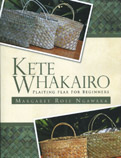
Kete Whakairo: Plaiting Flax for Beginners
Margaret Rose Ngawaka. Trafford Publishing, 2013.
Buy online from  Fishpond or Amazon.
Fishpond or Amazon.
Illustrated with colour photos, Kete Whakairo shows how to weave a traditional Māori kete (basket) with a different technique from that shown in Te Mahi Kete. The technique in Kete Whakairo involves joining a flat piece of weaving into a cylinder, weaving a plait around the top of the cylinder, joining the bottom of the cylinder together, and then turning the cylinder inside out to make the basket. Like Te Mahi Kete, Kete Whakairo illustrates one of the basic techniques for weaving a large kete. The technique in either book provides a basic kete structure that can be used for the more advanced coloured or self-patterned designs, such as those shown in Raranga Whakairo.
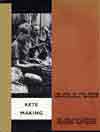
Kete Making: The Arts of the Maori
New Zealand Department of Education, 1975.
Out of print (only available through New Zealand public libraries).
Written for children, this booklet contains basic instructions for weaving a kete starting with a plait at the base, along with clear line drawings and black and white photos. It also includes information on weaving four corners, plaiting handles and finishing the top edge by incorporating a separate plait. There are brief instructions on weaving a patterned kete and diagrams of seven different patterns to weave with.

Weaving: The Arts of the Maori
New Zealand Department of Education, 1985.
Out of print (only available through New Zealand public libraries).
Written for children, this booklet contains instructions for weaving a mat, headband, food basket or rourou or kono, and a simple oval basket. It also has brief instructions on weaving a four-cornered basket starting with a plait. Clear line diagrams and black and white photos illustrate the weaving techniques.

Know Your Maori Weaving: Plaiting – Weaving – Tukutuku – Whakatauki
Murdoch Riley. Viking Svenseas NZ Ltd, 2005.
Buy online from Collectiblebooks (not offered by Fishpond or Amazon).
This Pocket Guide is full of good information on the diversity of weaving in New Zealand, and briefly describes the methods used to make baskets, skirts, poi and decorative panels. It also includes information on which native plants can be used to obtain dyes. The delightful cover illustration and two illustrations in the book depict paintings by Gottfried Lindauer, a New Zealand artist whose work is known for its authenticity in recording the customs and the way of life of the Māori people of his era (1839–1926).

Te Kono Naku Raranga Harakeke
Jan van de Klundert. Nga Puna Waihanga, 1996.
Out of print. Check for second-hand copies at Amazon or Abebooks.
Jan’s innovative work illustrates the flexibility and versatility of flax weaving as a sculptural medium. His instructions for a food basket and a kete are non-traditional and he includes ideas on different ways a plait can be used to start weaving, how to add or decrease the number of woven strips and how to weave with a vertical or horizontal twill. There are also instructions for a round basket which starts with two plaits, a hat and masks. Photos of Jan’s contemporary designs will provide inspiration for anyone interested in exploring new ways of working with flax.
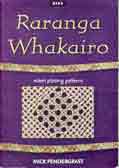
Raranga Whakairo: Maori Plaiting Patterns
Mick Pendergrast. Reed Publishing (NZ) Ltd, 1984.
A limited number of copies are available from
Andrew Pendergrast (not offered by Amazon).
Patterned weaving is an attractive feature of traditional flax weaving and this book illustrates, with clear black and white line drawings, how to set the patterns for a large number of coloured and self-patterned weaves. Each pattern’s origin and original weaver is documented along with some indication of how the pattern is executed. Some of the patterns are straightforward to interpret and set up but some of the more complex diagrams will require careful thinking and preparation to complete.

Maori Fibre Techniques: A Resource Book for Maori Fibre Arts:
Ka Tahi: Hei Tama tu Tama
Mick Pendergrast. Reed Publishing (NZ) Ltd, 2005.
Buy online from Collectiblebooks (not offered by Fishpond or Amazon).
Describing a variety of different fibre techniques used by Māori and other Pacific cultures, the author connects weaving of the Pacific region to the universal world of basket-making. He documents many of the traditional Māori techniques used in making clothes, baskets, nets and wall panels, illustrating these with close-up photos and clearly-drawn diagrams. Techniques from other cultures include three-directional plaiting (weaving) and right-angled plaiting, which are both useful for creating different shapes.
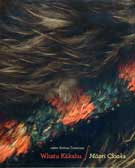
Whatu Kakahu / Maori Cloaks
Awhina Tamarapa (Editor). Te Papa Press, 2011.
Buy online from Te Papa, or Fishpond. (Not offered by Amazon.)
This sumptuously illustrated book opens the storeroom doors of Te Papa Museum's cloak, or kākahu, collections to reveal the treasures within. It illuminates the magnificent cloaks in those collections and the art and tradition of whatu, or finger weft-twining, which reaches its highest expression in the form of the prestigious kākahu - the Māori cloak. Five informative chapters, each written by an expert contributor, reveal the history and significance of the weaving of cloaks. Every page is illustrated with detailed photographs and the techniques are further illustrated by fine line drawings. Forty rare kākahu are featured within this book and these are accompanied by descriptions which bring together information on every cloak - its age, materials, and weaving technique with quotes from master weavers and other experts, stories of the cloaks, and details of their provenance. A full glossary, illustrated guide to cloak types, and index are included. This book is fascinating reading both for those interested in weaving a kākahu and in the craft of weaving in general.

Weaving a Kakahu
Diggeress Te Kanawa. Puwaha ki te Ao Trust, 2006.
Original edition Bridget Williams Books, 1992.Buy online from McLeods Books
Diggeress Te Kanawa, one of the most well-known weavers of her time, describes in complete detail how to construct a cloak in your own design using dyed flax, feathers and tassels. The book includes ideas for designs, gathering and stripping the flax, separating out and twining the fibre, gathering and preparing natural dyes and then dyeing the fibre, preparing feathers, and a detailed description of the weaving method (a form of twining), adding shaping to the weaving and tāniko weaving for the border. The materials list of "700 warp threads, 2 long cords dyed black, at least 5 hanks of weft thread (50 threads to one hank), feathers from 4 birds, and 200 tassels" -- all of which need to be prepared by hand before the weaving has even started -- illustrates the enormous amount of work that goes into the making of a cloak! This book is an excellent guide if you’re going to do just that.
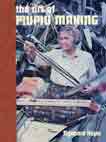
The Art of Piupiu Making
Ngapare Hopa. AH & AW Reed Ltd, 1971.
Out of print. Check for second-hand copies at Amazon or Abebooks.
This book covers, in very comprehensive detail, the traditional way to make a skirt or piupiu. It describes the preparation of the flax, assembly of the prepared pieces, the dyeing of the flax once assembled into a skirt and the weaving of a plaited or geometrically-patterned waistband. The step-by-step instructions are easy to follow and are illustrated with line drawings and black-and-white photos.
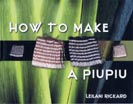
How to make a Piupiu
Leilani Rickard. Penguin Books Ltd, 2008.
Buy online from Fishpond (not offered by Amazon).
Leilani Rickard explains, with full colour photos, the methods used in making a piupiu. All the techniques used to make a piupiu are illustrated, including cutting and stripping the flax into strips, marking and scraping the patterns onto the strips, boiling, the twisting of flax fibre into cords to make the waistband, and traditional mud-dyeing of the completed piupiu. If you are using the information in this book to make a piupiu, do study the flow chart on pages 90-91, as it combines all the methods and techniques in a step-by-step plan.

Ceremonial Costume: The Arts of the Maori
New Zealand Department of Education, 1978.
Out of print (only available through New Zealand public libraries).
Although this is a small booklet, it is an excellent resource for anyone wanting to make their own basic skirt, bodice, headband or body band to wear at ceremonial occasions. The instructions for making a skirt show how to scrape traditional geometrical designs onto flax strips in preparation for dyeing them, and how to plait the strips into a waistband. Two different methods are described for making geometrical designs for a fabric bodice, head band and body band. In the first, geometrical designs are put onto tapestry cloth with cross stitch before the article is made and in the second, the tāniko method of weaving is used.

Te Whatu Taniko
Hirini Moko Mead. Reed Publishing (NZ) Ltd, 1999.
Buy online from Fishpond (not offered by Amazon).
First published in 1968, when the author went under the name of Sydney Mead, this book contains an interesting history of cloak and skirt making, and the changes in fashion in these garments through the centuries. The tāniko weaving technique is described in detail, including the preparation of the fibre. Also included are numerous graphed tāniko patterns, and an analysis of the historical development of tāniko designs.
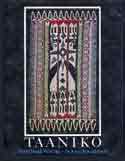
Taaniko: Maori Hand-weaving
Joyce Ronald Smith. Octopus Books Ltd, 1975.
Out of print. Check for second-hand copies at Amazon or Abebooks.
The author of this book is an American who lived for a brief time in New Zealand and taught herself tāniko weaving while on the voyage to New Zealand. There are step-by-step diagrams on weaving in the tāniko style and some alternative weaving techniques that can be used to achieve the same result. The author has developed her own style of tāniko weaving, examples of which are illustrated in the book.

Tukutuku and Kowhaiwhai: The Arts of the Maori
New Zealand Department of Education, 1976.
Out of print (only available through New Zealand public libraries).
This booklet for children describes the making of decorative wall panels, or tukutuku panels, and includes traditional patterns as well as patterns designed by children. The second part describes a simple process of designing traditional patterns known as kowhaiwhai patterns which are useful in many design situations.

Fibre Basketry: Homegrown and Handmade
Helen Richardson, editor. Kangaroo Press, 1989.
Out of print. Check for second-hand copies at Amazon or Abebooks.
This book contains a great deal of useful information on the use of flax in weaving even though the baskets described are made with coiled and stitched methods rather than the woven method that is generally used for flax weaving in New Zealand. A comprehensive table lists how various different natural materials can be used in basket making and there are good illustrations of baskets that have been made using the different techniques.

Baskets in Polynesia
Wendy Arbeit. University of Hawaii Press, 1990.
Buy online from Amazon, (not offered by Fishpond).
This book documents the great diversity in the weaving styles of baskets throughout the Pacific Islands of Fiji, Tonga, Samoa, the Cook Islands and French Polynesia, and illustrates these differences with many photos. Some basic weaving techniques are detailed at the end of the book.

Raranga: Māori Weaving
Cath Brown and Steve Gerrard.
Christchurch Teachers College Video Production Unit, 1990.
Only available through New Zealand public libraries (Ref: 746.41 NZ RAR)
A series of three video programmes in which the late Ngai Tahu weaver, Cath Brown, demonstrates the weaving of a floor mat, a food basket in a Pacific Island style and a two-cornered kete. It was made in the 1990s as a teaching resource for students at the Christchurch Teachers College and the demonstrations are easy to follow. The video provides an interesting glimpse of how a very experienced weaver worked with flax.

Piupiu: An episode of the TVNZ programme Waka Huia
Television New Zealand archive video, 1989.
Only available through New Zealand public libraries (Ref: 746.45 PIU)
Emily Schuster of Rotorua, a well-known craftswoman, demonstrates and describes most of the processes involved in weaving in the piupiu style, used for making skirts and capes. There is interesting footage of Emily dyeing flax in the traditional method using a natural mordant and black mud. The dialogue is all in Māori.

Art/Craft: Four episodes of the TVNZ programmes Koha and Handmade
Television New Zealand archive video
Only available through New Zealand public libraries (Ref: 704.03994 ART)
This video has segments on the art of traditional tattooing, or moko, the preparation and making of traditional Māori fishing nets, the collection and preparation of flax, the weaving of baskets, and the making of traditional wind instruments. There is unique footage on making a river fishing trap using supplejack vines as a frame and flax for the net, with step-by-step footage of the netting knot used for tying the flax. The close-ups show that the knot is similar to that used by fishermen throughout the world.

New Zealand flax : a fortunate fibre
Tom Williamson Productions Ltd, 2004
Available through New Zealand public libraries
This video provides a pictorial history of the flax milling industry in New Zealand and shows the Templeton Flax Mill Historic Museum in action. It also has a long section on the process of rope-making, both in New Zealand and overseas, and traces the decline of the flax rope-making industry in New Zealand.back to top
Books of flaxwork collections

The Art of Maori Weaving: The Eternal Thread
Miriama Evans and Ranui Ngarimu. Huia Publishers, 2005.
Buy online from Fishpond or Amazon.
The book complements the Eternal Thread exhibition which recently toured the USA and New Zealand. It’s full of beautiful colour photos of contemporary and traditional weaving by some of New Zealand’s foremost Māori weavers. Each featured piece of weaving includes detailed descriptions of the methods used to make it, and close-up photos of selected areas provide good illustrations of particular techniques. This is an excellent reference book which celebrates the diversity and creativity of flax weaving in New Zealand.
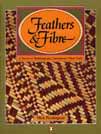
Feathers and Fibre: A Survey of Traditional and Contemporary Maori Craft
Mick Pendergrast. Penguin Books (NZ) Ltd, 1984.
Out of print. Check for second-hand copies at Amazon or Abebooks.
This book illustrates the Feathers and Fibre exhibition held at the Rotorua Art Gallery in New Zealand in 1984, which included a wide variety of different baskets, cloaks, belts, covered gourds, kites, mats, fish traps, fans, hats, poi and tāniko weaving. The photos are mostly in black and white and include close-up views of weaving techniques of particular interest. At the back of the book there is a description of each article, the artist, and any unusual or interesting feature of the weaving. A good book to browse through for weaving ideas.

He Kete He Korero: Every Kete Has a Story
Toi Te Rito Maihi and Maureen Lander. Reed Publishing (NZ) Ltd, 2005.
Buy online from Fishpond or Amazon.
This delightful book describes the personal and historical significance of a diverse collection of twenty-one ketes. The ketes all have a connection with the north of New Zealand and range from the beautifully simple seed kumara kete, to ketes made with pingao, lacebark and even seaweed. Large colour photos illustrate each kete and their current owner and close-up photos provide further information on the methods of weaving.

Te Aho Tapu: The Sacred Thread
Mick Pendergrast. Reed Publishing (NZ) Ltd, 1987.
Out of print. Check for second-hand copies at Amazon or Abebooks.
This book is based on the Te Aho Tapu exhibition of traditional Māori clothing, mainly cloaks, put on by the Auckland Institute and Museum. The exhibition was planned to coincide with the Te Māori exhibition which toured the United States in 1984, later returning to tour New Zealand. Illustrated with colour photos, there is a huge amount of information in the descriptions of the different types of cloaks and their manufacture. Cloaks are catalogued by type, name of weaver if known, measurement, materials used and other general information.
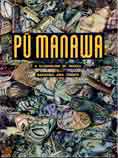
Pu Manawa: A Celebration of Whatu, Raranga and Taaniko
Megan Tamati-Quennell. Museum of NZ Te Papa Tongarewa, 1993.
Out of print. Check for second-hand copies at Amazon or Abebooks.
This book is published as part of Pū Manawa, an exhibition put on by the Museum of New Zealand Te Papa Tongarewa in 1993. Illustrated in colour, the book features a wide range of flax art and craft works by twenty-one Māori women and includes their thoughts on the meaning of weaving.
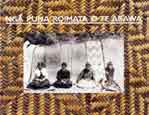
Nga Puna Roimata o te Arawa
Museum of New Zealand Te Papa Tongarewa, 1993.
Out of print. Check for second-hand copies at Amazon or Abebooks.
This booklet catalogues the exhibition of three Te Arawa women — Makereti Papakura, Te Hikapuhi Poihipi 2, and Rangimahora Reihana-Mete. There is a short history of each woman’s life and the illustrations show their cloaks, skirts and ketes.
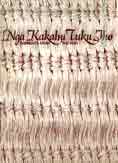
Nga Kakahu Tuku Tho: Garments from the Past
Mary Reid. Masterprint Printers Ltd, 1987.
Out of print. Check for second-hand copies at Amazon or Abebooks
This is a programme of an exhibition held at Taranaki Museum in 1987, published in black and white. An attractive feature is the cover, which is a close-up drawing of single and double twining, or whatu. The programme lists details of the cloaks and skirts in the Taranaki Museum’s holdings that were displayed in this exhibition.

Puawaitanga o te Ringa — Fruits of Our Busy Hands
Patricia Wallace. Christchurch City Libraries, 2003.
Out of print but you can read this book online.
Pūawaitanga o te Ringa — Fruits of Our Busy Hands is the name given to a series of decorative tukutuku panels which were especially woven as a community project for the Christchurch Central City Library’s new Ngā Pounamu Māori Centre. Illustrated in colour, the booklet includes a brief description of the community development of the Janet Stewart reserve, where the flax for the panels was harvested, and the progress and final installation of the panels.

Creative Fibre
Journal of the New Zealand Spinning, Weaving and Woolcrafts Society
Inc. Published quarterly. Available from Creative Fibre.
Creative Fibre is a national organisation for all fibre crafts and it includes spinners, weavers, knitters, dyers, flax workers, felters, crocheters, free-form fibre artists and all other people involved in the use of fibre. Regional and national exhibitions are held on a regular basis and examples of flax weaving are often entered in these exhibitions. Although most of the images in the magazine are from other fibre crafts, every now and then, flax works will be illustrated in the magazine.
Books and a video on the role of flax within traditional Māori culture

Te Roopu Raranga Whatu o Aotearoa
Magazine of Toi Maori Aotearoa, published 2-3 times per year.
Available from Toi Maori Aotearoa.
This magazine, produced by Toi Moari Aotearoa, a national organisation promoting Maori art, is produced specifically for flax weavers. It includes weaver profiles, articles about plants used for weaving, discussion on Maori art, reviews of exhibitions and gatherings and gives information on coming events. Back issues of the magazine are available for purchase.

The Coming of the Maori
Te Rangi Hiroa, Sir Peter Buck. Whitcombe and Tombs Ltd, 1949.
Out of print. Check for second-hand copies at Amazon or Abebooks.
Regarded as a definitive work on Māori culture, this book has information on the discovery of New Zealand and the early settlement periods, the material culture of the Māori, including a descriptive section on flax weaving, the social organisation and the religion. There are clear instructional line drawings of weaving techniques that are used for pandanus, coconut leaf, palm leaf and flax.

Kakahu Maori Cloaks
Mick Pendergrast. David Bateman Ltd, 1997.
Buy online from Fishpond or Amazon.
The history of cloaks and the evolution of weaving styles are discussed in depth in this informative booklet. A brief description of selected techniques used in weaving cloaks leads onto descriptions of all the major traditional styles — rain capes, kahu kuri, pukupuku, kaitaka, korowai, karure and ngore and kahu huruhuru. The booklet finishes with a discussion of the resurgence of interest in cloak-weaving in the twentieth century.

A Tohunga’s Natural World: Plants, gardening and food
Paul Moon. David Ling Publishing Limited, 2005.
Buy online from Fishpond.
Written in a narrative style, this book follows conversations the author has with Hohepa Kereopa, a tohunga, or expert in the traditional Māori way of life. The practical information, covering gardening, food, harakeke (flax) and the medicinal uses of plants, is interspersed with Hohepa's observations on the changing nature of traditions, the metaphysical realm and the relationships people have with their environment. The section on harakeke describes how the traditions associated with flax weaving give an understanding of family history, or whakapapa and a sense of community. This is an interesting glimpse into the everyday life of rural Māori in the mid-twentieth century.

Rangimarie: Recollections of Her Life
Rora Paki-Titi. Huia Publishers, 1998.
Out of print. Check for second-hand copies at Amazon or Abebooks.
A down-to-earth narration of the life of the well-known weaver, Rangimārie Hetet, and how weaving became an important part of her life. Old black and white photos illustrate her life, and her extended family, and colour photos illustrate her weaving.

Fishing Methods and Devices of the Maori
Elsdon Best. Te Papa Press, 2005.
Buy online from Fishpond or Amazon.
Elsdon Best (1856-1931) was an ethnologist with the Dominion Museum for 20 years and New Zealand’s foremost writer on pre-European Māori life. Of interest in this book is a section on the way flax was used to make fishing nets and traps. There is a fascinating description on the manufacture and use of deep-sea fishing nets, some of which were up to 1,000 yards long, and required several hundred men and double canoes to take them out to the fishing beds.

Forest Lore of the Maori
Elsdon Best. Te Papa Press, 2005.
Buy online from Fishpond (not offered by Amazon).
Although there is very little information on flax weaving in this book, the image of a preserved-bird container on the cover is stunning. The container is a gourd that has been cut off at the stem and covered with woven dyed flax. The vessel has three or four wooden legs attached to two wooden hoops and is adorned with feathers. Traditionally, these decorated containers were used on festive occasions.
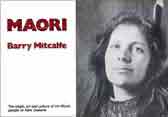
Maori: The Origin, Art and Culture of the Maori People of New Zealand
Barry Mitcalfe. Coromandel Press, 1981.
Out of print. Check for second-hand copies at Amazon or Abebooks.
Reconstructing Māori life on the basis of archaeological evidence, this book has many photos of historical woven cloaks, skirts and baskets. There are also several photos of korowai cloaks and a wonderful photo of a large kete being used for kumara gathering.
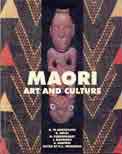
Maori Art and Culture
D C Starzecka (Editor). David Bateman Ltd, 1986.
Out of print. Check for second-hand copies at Amazon or Abebooks.
This book was written to complement an exhibition of Māori art and culture at the British Museum in 1998, and has chapters by different authors on Māori prehistory, culture, contemporary society, wood carving, the fibre arts and a description of the Māori collections in the museum. Of particular interest is Mick Pendergrast’s chapter, The Fibre Arts, which is a comprehensive essay on the history of the use of fibre in Māori culture with descriptions of the materials used for weaving, especially flax, the techniques used to weave flax and the items made with it. Particular emphasis is given to the historical development of cloak making. The book is illustrated with colour and black and white photos of items in the British Museum.

New Zealand Medicinal Plants
S G Brooker, R C Cambie, R C Cooper. Heinemann Publishers, 1987.
Out of print. Check for second-hand copies at Amazon or Abebooks.
Along with information on many other plants, this book details the traditional use of flax for a wide variety of medicinal purposes, including poultices, ointments, and internal use. It also includes some notes on the biochemistry of flax extracts.

Greenstone Trails: The Maori Search for Pounamu
Barry Brailsford. Reed Publishing (NZ) Ltd, 1984.
Out of print. Check for second-hand copies at Amazon or Abebooks.
Barry Brailsford describes in detail both the Māori and European expeditions in search of greenstone, or pounamu, in the South Island of New Zealand. Items made with flax played a major part in these expeditions, one of the more dramatic examples being the use of flax ropes to scale cliffs. Flax was also used for sandals, basketry and clothing and flower stalks lashed together were used to make rafts for crossing rivers.
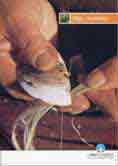
Flax – Harakeke
Christchurch City Council.
Available free from Service Centres of the Christchurch City Council.
This leaflet has information on the two main types of flax, the traditional protocols associated with harvesting and managing flax, and the ways that both Māori and pakeha (European settlers) have used flax over the centuries. The leaflet has good colour photos including photos of patterned baskets made with dyed flax.

Tu Tangata: Weaving for the People
Video available only through New Zealand public libraries (Ref: 746.42 PUK)
This video features the well-known weaver Erenora Puketapu-Hetet’s life-long involvement in Māori craft. Erenora shares her knowledge and views, as we see her collecting and dyeing kiekie for weaving, weaving kiwi feathers into a cloak using the tāniko technique, and preparing flax fibre for weaving. Made late in the twentieth century, this video gives a glimpse of the resurgence of Māori culture, or Māoritanga, of that time, and her hopes and fears for the future of one Māori community.back to top
Books on growing and harvesting flax
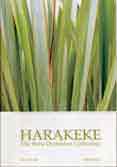
Harakeke: The Rene Orchiston Collection
Sue Scheel and Geoff Walls. Manaaki Whenua Press, 2005.
Buy online, or download a free 2Mb PDF file, from Manaaki Whenua.
This booklet describes the leaves, flowers and the most suitable weaving uses for sixty-three different flax varieties, some of which are illustrated with colour photographs. This collection was gathered and catalogued by Rene Orchiston over many years and from many parts of New Zealand, and is now cared for by Manaaki Whenua Landcare Research at Lincoln, Christchurch.

Insect Pests and Diseases of Harakeke
Sue Scheele. Manaaki Whenua Press, 1998.
Buy online from Fishpond (not offered by Amazon).
For those growing and looking after their own flax bushes, this book has essential information on keeping bushes free of pests and diseases. There are good descriptions and diagrams of the main insects that attack the flax plant and how to prevent and control these pests. These include natural control measures, insecticide sprays and home remedies.

Pīngao: The Golden Sand Sedge
Nga Puna Waihanga, 1991.
Out of print (only available through New Zealand public libraries).
Pīngao, a golden sand sedge, is a favoured weaving plant because of the rich yellow colour it dries to. Pīngao’s growth declined in the first half of the twentieth century, and this booklet was written to promote the reintroduction of it both in public and private plantings. The booklet contains practical information on how to propagate and grow pīngao from seed and cuttings and a description of the plant’s use for erosion control and dune rehabilitation. There are good coloured images throughout the book, including an interesting image of the extensive use of pīngao in a tukutuku panel.
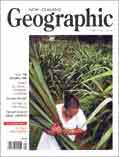
Flax — The Enduring Fibre
Feature article in New Zealand Geographic, Number 42, April–June 1999.
This issue is available as a back copy from New Zealand Geographic.
A very readable article that focuses on the way the flax plant has been used in New Zealand. It describes the different types of flax plants, and the origin of the Rene Orchiston collection at Manaaki Whenua Landcare Research, and goes on to discuss the importance of flax in early Māori culture. A section on the conservation work being carried out to preserve old flax artefacts includes the degradational effects of traditional dye methods on the flax fibre. The article also describes the role that the flax-milling industry played in New Zealand history, the breeding of coloured, ornamental cultivars, and the part flax plays in modern technology, medicine and fashion. Another section describes the insect life on flax plants. The Linen Years describes the growing of European flax, Linum usitatissimum, in New Zealand as a contribution to the manufacture of Britain’s war equipment during World War Two. Good colour and black and white photos complement the article.

